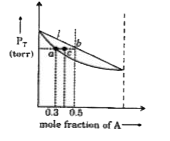Iron (II) oxide has a cubic structure and each unit cell ha side 500 pm. If the density of the oxide is 4 g cm−3 the no. of oxide ions present in each unit cell is_____. (Molar mass of FeO=72g mol−1,NA=6.02×1023mol−1).Solution in Malayalam
The Density is given by ρ=z×Ma3×NA. Therefore, 4=z×72500×500×500×10−30×6.02×1023⇒z=4
Topper's Solved these Questions
- SOLID STATEBOOK - BRILLIANT PUBLICATIONCHAPTER - SOLID STATEEXERCISE - LEVEL-3 (Statement Type)
5 Videos
- SOLID STATEBOOK - BRILLIANT PUBLICATIONCHAPTER - SOLID STATEEXERCISE - LEVEL-3 (Linked Comprehension Type)
10 Videos
- SOLID STATEBOOK - BRILLIANT PUBLICATIONCHAPTER - SOLID STATEEXERCISE - LEVEL-3 (Matching Column Type)
5 Videos
- REDOX REACTION & ELECTROCHEMISTRYBOOK - BRILLIANT PUBLICATIONCHAPTER - REDOX REACTION & ELECTROCHEMISTRYEXERCISE - QUESTION (ELECTROCHEMISTRY) (LEVEL -II) (ASSERTION-REASON)
3 Videos
- SOLUTIONSBOOK - BRILLIANT PUBLICATIONCHAPTER - SOLUTIONSEXERCISE - Level-III (Linked Comprehension Type)
12 Videos
Similar Questions
Statement 1: In crystal lattice, the size of the tetrahedral void is larger than an octahedral void.
Statement 2: The cations occupy less space than anions in crystal packing.
View SolutionF centre is an example of metal excess defect due to the presence of extra cations at interstitial sites. Zinc oxide is white in colour at room temperature, on heating it loses oxygen and turns yellow.
ZnOHeat−−→Zn2++12O2+2e−
Now there is excess of zinc in the crystal and its formula becomes Zn1+x O. the excess of Zn2+ ions move to interstitial sites and the electrons to neighbouring interstitial sites.
There are many solids which are difficult to prepare in the stiochiometric composition and contain less amount of the metal as compared to stiochiometric proportion. a typical example of this type is FeO which is mostly found with a composition of Fe0.95. it may actually range from Fe0.96 O.
Q. In Fe0.95 O:
View SolutionMatch the crystal systems/unit cells mentioned in Column I with their characteristic features mentioned in Column II.

View SolutionAssertion: After the electrolysis of aqueous CuSO4 solution pH decreases.
Reason: Sulphuric acid is formed.
View Solution1 mole of A and 1 mole B are mixed together to form an ideal solution at 25∘C. Solution is placed in a vessel fitted with piston. If pressure on the solution is reduced isothermally.

Correct relationship between P∘AandP∘B is
View SolutionFerrous oxide (FeO) crystal has a cubic structure and each edge of the unit cell is 5.0 A^(@) Taking density of the oxide as 4.0gcm^(-3) . The number of Fe^(2+) and O^(2-) ions present in each unit cell is:
View SolutionThe cubic unit cell of Al (molar mass 27 g mol−1 has an edge length of 405 pm. Its density is 2.7 g cm−3). The cubic unit cell is
View SolutionIron (II) oxide has a cubic structure and each unit cell has side 5Å. If the density of the oxide is 4 g cm^(-3) , the number of oxide ions present in each unit cell is ("Molar mass of " FeO = 72 g " mol "^(-1),N_(A) = 6.02times10^(23)"mol^(-1))
View SolutionIron (II) oxide has a cubic structure and each unit cell has side 5 Å . If the density of the oxide is 4 g cm^(-3) Calculate the number of Fe^(2+) and O^(2+) ions presnent in each unit cell ( Molar mass of FeO = 72 " g mol"^(-1) N_(A) = 6.02 xx 10^(23) "mol"^(-1) )
View SolutionIron (II) oxide has a cubic strcuture and each unit cell has side 5 Å. If the density of the oxide is 4 g cm−3, the number of oxide ions present in each unit cell is ( Molar mass of FeO = 72g mol−1,NA=6.02×1023mol−1
View SolutionIron (II) oxide has a cubic structure and each unit cell has side 5 Å . If the density of the oxide is 4 g cm−3 Calculate the number of Fe2+andO2+ ions presnent in each unit cell ( Molar mass of FeO = 72 g mol−1
NA=6.02×1023mol−1 )
View SolutionIron (II) oxide has a cubic structure and each unit cell has side 5 Å. If the density of the oxide is 4 g cm^(-3) , the number of oxide ions present in each unit cell is (Molar mass of FeO = 72 "g mol"^(-1) , N_A=6.02xx10^23 mol^(-1) )
View SolutionA metal has a fcc lattice.The edge length of the unit cell is 404 pm ,the density of the metal is 2.72gcm−3 . The molar mass of the metal is (NA, Avorgadro's constant =6.02×1023mol−1)
View SolutionA metal has a fcc lattice. The edge length of the unit cell is 404 pm. The density of the metal is 2.72 g cm−3. The molar mass of the metal is (NA Avogadro's constant=6.02×1023mol−1)
View Solutionफेरस ऑक्साइड की संरचना सरल घनीय है और इसके एकक सेल का प्रत्येक किनारा 5.0 Å है। इस ऑक्साइड का घनत्व 4.0 ग्राम सेमी−3 मानकर Fe2+ और O2−आयनों की संख्या प्रत्येक एकक सेल में होगी
View SolutionThe cubic unit cell of Al ( molar mass = 27 g mol−1) has an edge length of 405 pm. Its density is 2.7gcm−3. The cubic unit cell is :
View Solution
